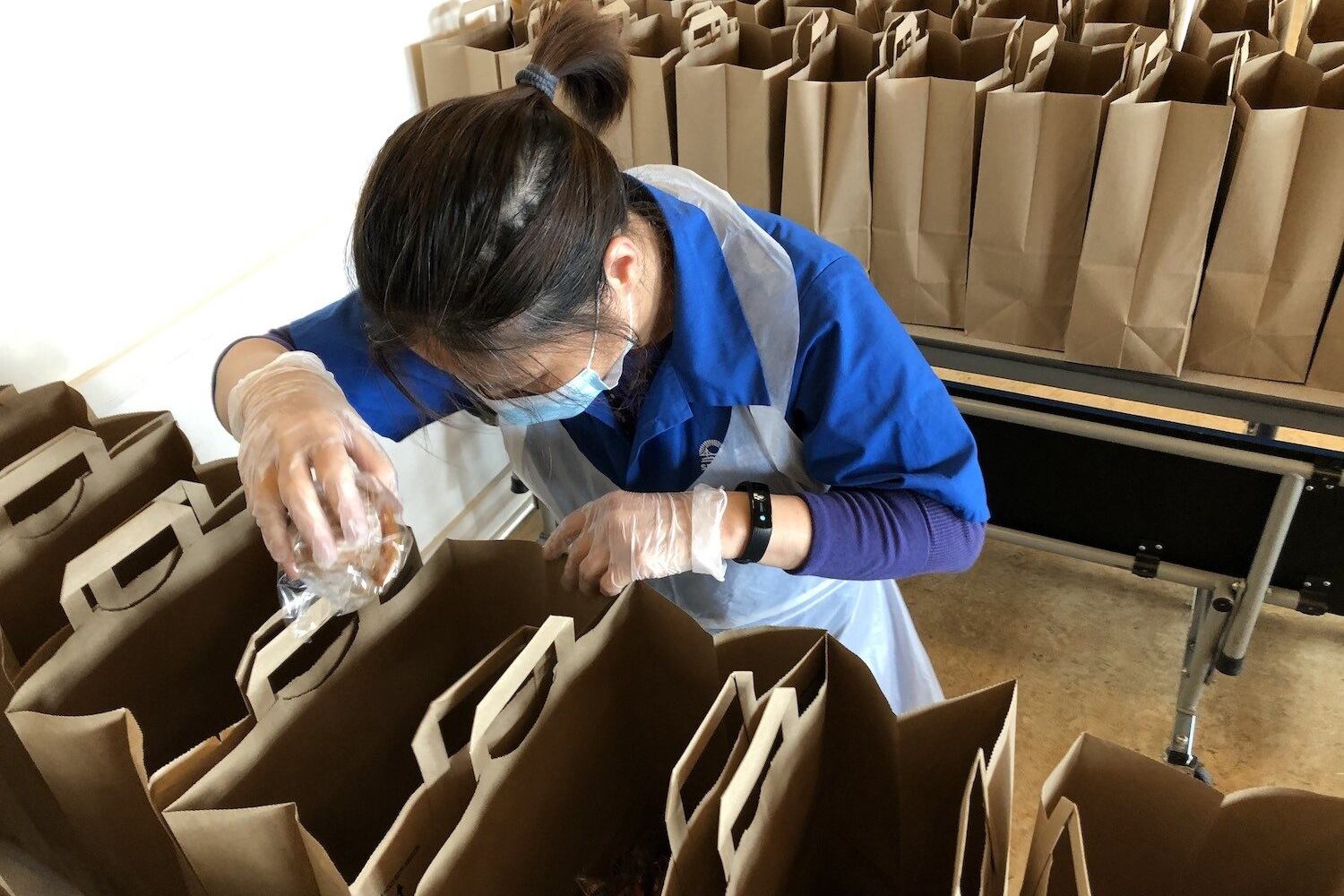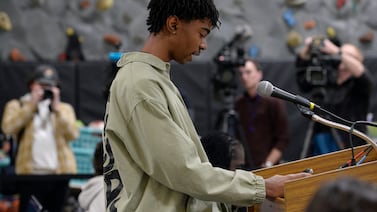This piece was produced by The Counter, a nonprofit newsroom investigating the forces shaping how and what America eats.
The school cafeteria as we know will be unrecognizable when the next academic year begins in the fall, whether or not in-person instruction resumes. Instead of eating in the familiar, raucous spaces they remember, students can instead look forward to breakfast and lunch in their classrooms, or more of the take-home meals that districts have conjured on the fly to replace their conventional food-service programs.
Across the country, school cafeterias have been emptied by the Covid-19 pandemic and meal-service staff have upended their operations entirely: More than 80 percent of schools now offer food via drive-through pick up, and over half offer walk-up services, according to a recent School Nutrition Association survey.
Even policy — typically onerous and slow to move — adapted: This month, the Department of Agriculture extended a crucial waiver that allows all school districts, not just those in poor neighborhoods, to provide free meal service this summer. And while traditional programs are required to feed kids on-site, the agency in May extended waivers that allow schools to operate grab-and-go models and permit parents to pick up food on their children’s behalf.
School nutrition directors say they’re all but guaranteed to need future extensions; they won’t be able to resume regular operations for months — possibly even years.
“My hope is that USDA extends those waivers until we have a cure, or until we have vaccines,” said Jennifer LeBarre, executive director of school nutrition services at San Francisco Unified School District, which serves over 60,000 kids. “Until we are back to normal or as close to normal as we possibly can be — which is anywhere from two to 10 years.”
Citing the futility of enforcing social distance guidelines in communal lunch rooms with hundreds of kids, many schools are now declaring those settings defunct — at least until the pandemic abates. In the meantime, school nutrition directors are reimagining what meal service should look like in the future, while trying to meet the needs of students and families during the immediate crisis.
“It is highly implausible for us to open up a school cafeteria in a traditional manner that most of us are used to seeing by the start of August,” said Jordan Gordon, director of child nutrition services at Kansas City Public Schools, one of Missouri’s biggest districts, serving more than 15,000 students. “It takes a lot of strategy and manpower and planning to open up a school in normal circumstances. But now we’re planning for completely abnormal circumstances.”
Colleagues across the country share Gordon’s uncertainty. With so much still unknown about the novel coronavirus — the scope of its spread, its long-term health consequences, potential cures or vaccines — nutrition directors are drawing up contingency plan after contingency plan to prepare for … well, anything.
“We do not see the kids eating in the cafeteria anymore,” said Ruth McDowell, director of school nutrition services for Edgecombe County Schools, which serves 6,000 students in rural Tarboro, North Carolina. “I don’t see that for the next school year. I really don’t.”
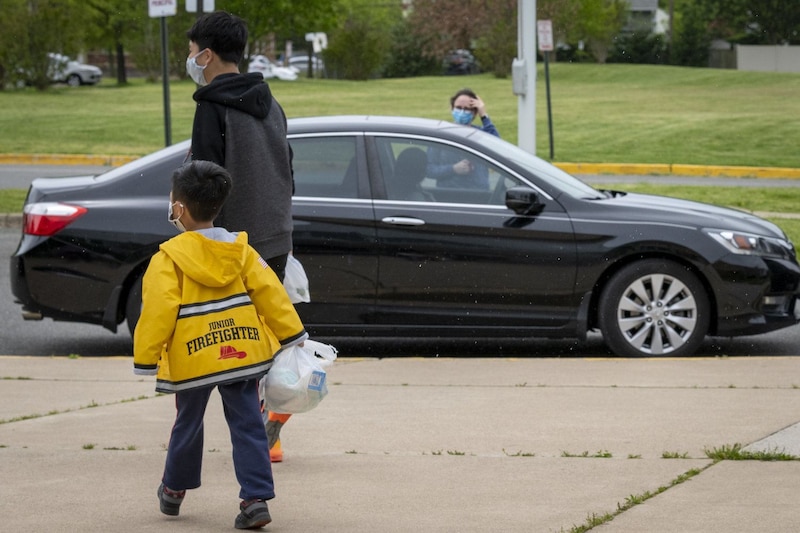
In fact, McDowell thinks that schools may have to do away with the lunch period itself. She envisions kids picking up meals from the cafeteria on a classroom-by-classroom basis, then eating during their lessons.
“Right now, kids have about 20 minutes to eat their meal,” McDowell said. “If [we have] them coming into the cafeteria and keeping six feet apart, they’ll take 20 minutes just to get through [the lunch line], let alone them sitting down and having that time to eat. When you do lunch in the classroom, it can be a part of class structure. So the kids are eating while teachers are teaching. Really, that’s the way I see them doing it. That way, it does not interfere with instruction.”
McDowell drew inspiration for this potential scenario from a popular breakfast-service model that provides kids with food during their first period rather than before the bell. Nutrition staffers cook and deliver meals to classrooms ahead of time, which can make eating breakfast at school a more inclusive and less stigmatizing prospect for students who rely on it. But as a lunch model, it can pose unique hurdles, particularly at larger schools that are considering a cafeteria-to-classroom delivery model.
“How do we have access to elevators, getting food up three stories and then to multiple classrooms?” asked LeBarre, who is also considering an in-classroom lunch model. “How do you do that safely? What menu do you serve? How do you deal with options? How do we deal with food allergies? All this kind of complexity we have to be rethinking at this point, as opposed to when you have students come to one place.”
Then there’s the issue of collecting lunch money. Schools that meet a certain threshold of participation in USDA’s free- and reduced-price lunch program — like those in Kansas City Public and Edgecombe County Schools — qualify for universal free lunch. That means USDA covers a significant share of schools’ lunch costs, doing away with the need to track account balances and chase unpaid debt. But at schools where free- and reduced-price lunch participation is lower, including some within the San Francisco Unified School District, nutrition staff will still have to deal with those thorny logistics next year — outside the cafeteria.
“It gets complicated at a school where you have to collect money from children,” said LeBarre. “If we’re talking about doing breakfast or lunch in the classroom and having to ask the teacher, for example, to collect money, that’s going to be a huge obstacle. It’s going to be a huge burden on that teacher and it’s going to take away from the time that that child needs to eat.”
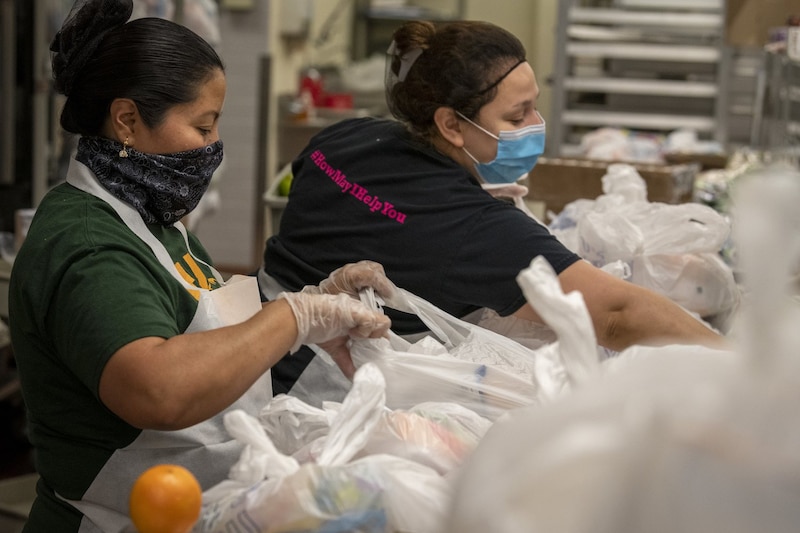
LeBarre is also planning for the possibility that students might attend school in shifts — a morning session for one half, an afternoon session for the other. Like other strategies designed to reduce student density, this one also comes with a problem: “If, for example, a student doesn’t come in until the afternoon, where’s their breakfast going to come from?”
Even small details like cutlery and packaging will be overhauled to reduce the risk of Covid-19 transmission, said Bertrand Weber, director of culinary and wellness services for Minneapolis Public Schools, which serves over 36,000 kids.
“We know that we will not have salad bars and self-service stations, at least for the foreseeable future,” Weber said. “There will be a lot more disposable ware.”
The countless variables are difficult enough. But what’s more disappointing is that Weber has had to suspend a number of sustainability projects he had in the works.
“We were about to embark on a two-month pilot at three high schools on plant-based protein,” he said. “So that’s on hold probably for another year. And we were increasing the amount of share tables in order to minimize food waste. We know that’s going to go away for the time being. We were rolling out bulk milk. That’s going away as well, because everything has to minimize cross-contamination and possible spreading of diseases.”
Of course, even the idea of implementing safeguards in the cafeteria depends on whether or not in-class instruction is possible come August or September. As of right now, that is far from guaranteed in most states. Dr. Anthony Fauci, director of the National Institute of Allergy and Infectious Diseases, has said that school reopenings will likely vary by region and look very different from state to state. To comprehensively prepare, nutrition directors have to draft multiple plans, tailored to every possible scenario.
For example, under one possible outcome, Kansas City’s Gordon is preparing for elementary students to be divided into two groups, each attending school in person on alternating days. Under this set-up, the district will implement a hybrid plan: classroom meal delivery and grab-and-go food services. On the other hand, if classes continue to take place online, the district will have to fine-tune its current distribution strategy, which won’t be feasible during colder months of the year.
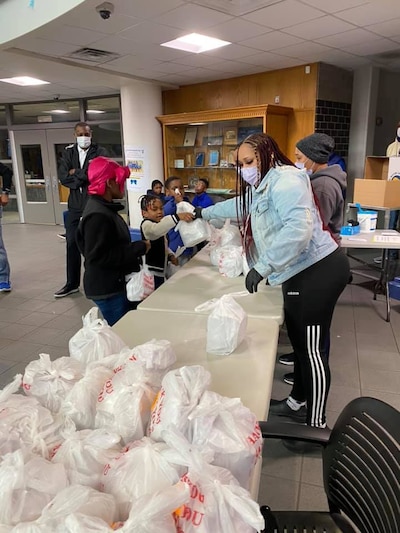
“We have distribution sites set up in each quadrant of the city: north, east, south, and west,” Gordon said. But when “the weather changes, that will have to evolve, too. Currently we’re [working] under a tent to service families. You can’t really do that through freezing temperatures, snow, or ice. Depending on how long [Covid-19 restrictions] go on, we will have to revisit that model.”
Complicating matters is financial hardship: The pandemic imposed unexpected budgetary pressures on lunch programs, which have generally struggled to stay in the black. Most school lunch programs operate at cost or at a slight deficit; their revenues cover 97 percent of expenses on average, according to a USDA report on the school lunch program published last year. Over 67% of school districts are projecting deficits this year, and just one-third say that they can cover financial losses with money from general funds, according to SNA’s survey.
The pandemic has ratcheted up operating costs for schools that are still providing meal service. Nutrition directors now have to factor in the cost of personal protective equipment for their staff, as well as ancillary spending on needs like extra food packaging. McDowell told me that high demand meant that her usual wholesale vendors were short on many shelf-stable foods and supplies, so she’s buying them at costs closer to retail. Because she is still serving a large number of students in rural North Carolina, she’s able to recoup most of her costs via USDA reimbursements, and feels relatively confident about balancing the books this year.
But not everyone will. Betti Wiggins, nutrition services officer for the Houston Independent School District, which serves more than 214,000 kids, is projecting a $20 million deficit by the end of this year. Wiggins is working in conjunction with food banks to distribute family food packs to students via a curbside pick-up model. Each pack contains 30 pounds of food, aimed at feeding a family of four for four days, and combines shelf-stable and fresh items, donated from food banks and the school’s unused supply. But USDA reimburses schools only on a per-meal-per-student basis. Wiggins’ family food packs don’t qualify.
“My position was: If you feed families, you’re going to feed kids,” Wiggins said, regarding her decision to serve family food packs rather than grab-and-go meals. “[If] you’re going to give a kid one meal, he’s going to take that meal home, and there’s [still] going to be hunger in his household.”
Though she’s not getting USDA reimbursements, Wiggins still has to pay her staff of 2,200 through the end of the school year. She estimates that her payroll costs equal about $1,000,000 a week. Because of the deficit, she expects to have short-term furloughs and will have to scale her program down to a bare-bones model next year. That means delaying equipment replacements and putting a farm-to-school initiative on hold.
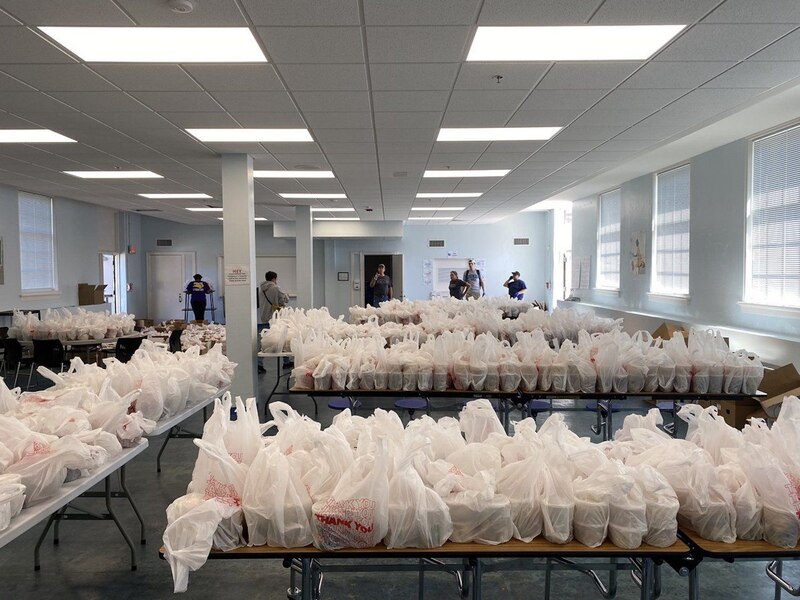
In addition, the many lunch programs that don’t qualify for universal free lunch found that their traditional revenue streams have evaporated along with mass school shutdowns.
“We depend on full-paid students and the à la carte sales for revenue sources,” said Juliana Fisher, director of food services at Northshore School District, serving 23,500 kids in suburban Seattle. Just 13% of Northshore’s students qualify for free- and reduced-price lunches. “In this emergency situation, while we do have more families needing meals, it doesn’t really cover the costs when we don’t have families spending cash and buying à la carte,” Fisher said.
Fisher doesn’t expect to make any layoffs right now, but she does expect to close out the school year at a deficit, which rarely happens.
“A big question for a lot of districts has been: ‘Where is this funding coming from?’” she said. “We’re getting reimbursement for the meals, but a lot of people are still coming way under on budget. That’s a big challenge — trying to continue to meet the needs of the community while also being fiscally responsible.”
Nutrition directors are calling for higher per-meal reimbursement rates from USDA and federal relief to cover Covid-19-related deficits. In April, SNA asked Congress to authorize $2.6 billion in funding to cover this year’s revenue losses, and to prevent lunch programs from having to dip into general school funds or open new lines of credit.
“USDA, similarly to a lot of other state, local and federal entities, has to provide some type of financial relief, [like] increased Covid-19 reimbursements for those of us who are out here trying to continue to work to feed our kids,” Gordon said. On May 11, House Speaker Nancy Pelosi introduced a new coronavirus relief bill dubbed the HEROES Act, which would authorize $3 billion in additional funding for child nutrition programs like school lunch, though it is unlikely to pass in the Senate.
While nutrition directors are drafting long-term school meal plans, they’re also keeping an eye on the more immediate need: summer service. For most, that will likely resemble the curbside pick-up and bus-based delivery models already in place.
What school meal service will look like when we flip the calendar to another academic year depends a lot on ever-evolving local and federal Covid-19 guidelines. Only one thing is certain right now: School meals will become increasingly integral to child nutrition as families grapple with pandemic-related unemployment and financial hardship.
“Our economy is going to take a long time to recover,” LeBarre said. “Our families are going to be relying on school meals more than ever.”
Correction: A previous version of this story misstated the extent of USDA’s reimbursement to schools that provide free lunch to all students. At schools with lower rates of free lunch participation, USDA pays for a significant share of free meals served, but not all.

